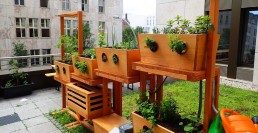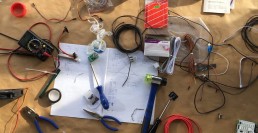Geco-Gardens: „As simple as Farmville – with real crops“
How Geco-Gardens enables you to grow your own food on your balcony
Hello, farmees out there! On the farmee blog, we also want to present other companies from the field of smart or urban farming. We start this series with a really cool startup from Germany called Geco-Gardens. Founder Bastian Winkler took some time for us to talk about his amazing product.
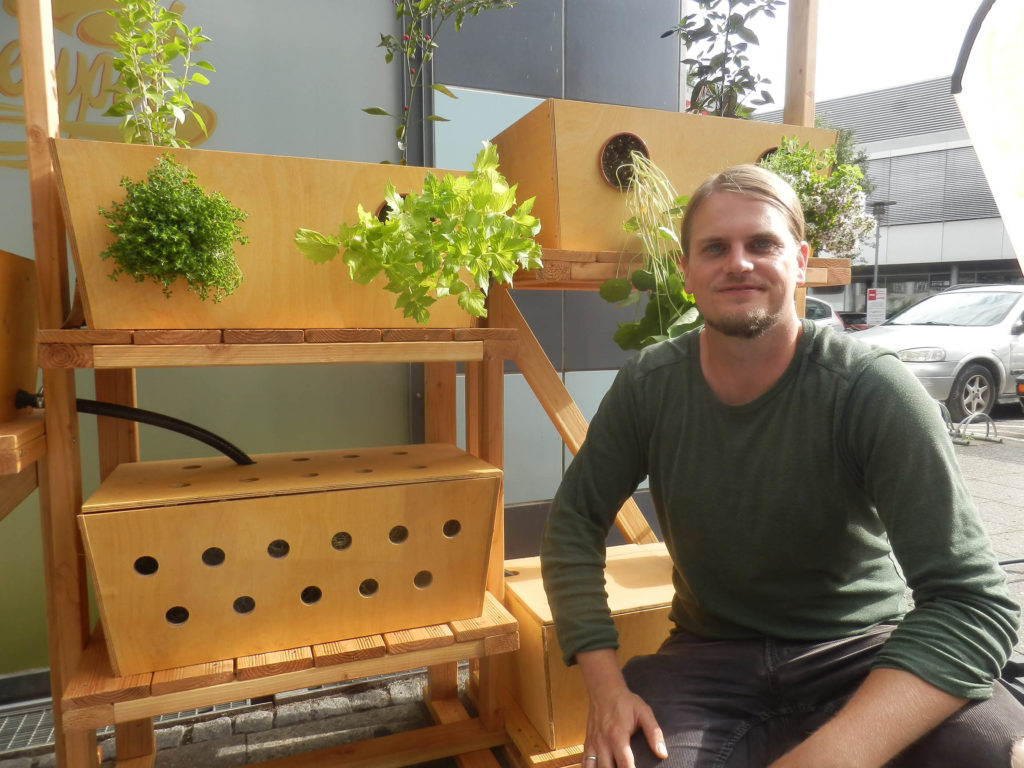
Q: Hi Bastian, tell us a little bit about Geco-Gardens. What are you doing?
Bastian: We are planning and constructing vertical, automated microgardening systems. With Geco-Gardens, people can grow their own organic vegetables, fruits, herbs and ornamental plants right in the middle of the city. This creates new gardening areas in front of your door, e.g. on balconies, patios, courtyards and rooftops.
The system consists of several planting containers, a vermicompost and a water tank. With energy from a solar panel, the water is pumped to the top and flows through all planting containers and the compost back into the water tank at the bottom. You put your organic kitchen waste into the compost box, where the compost worms transform it to a 100% natural fertilizer. These nutrients are washed out into the water tank, from where the water and nutrient cycle starts.
Q: Sounds awesome. How did you come up with the idea to develop your system?
Bastian: Currently I am doing research for my Ph.D. thesis at the University of Hohenheim (Southern Germany). It is about the introduction of renewable energy into smallholder agricultural systems in the emerging countries South Africa, India and Brazil. Aim is the creation of locally appropriate, integrated food and energy systems for the production of healthy food and renewable energy in an ecological and resource efficient way. To achieve that, the prodcution systems are based on locally available natural resources and on closed production and matter cycles.
During a research stay in South Africa, I got to know Luke Boshier, one of the pioneers in the field of integrated agricultural systems. Together we built a terrace cultivation system for an integrated ecological production of fish, rice and vegetables. Facinated by this resource-efficient way of production, which is independent of agricultural land, I adapted it for urban farming.
The fish were replaced by compost worms and the fish food by organic kitchen waste. The innovative, natural method called „terrabioponics“ was born. In Geco-Gardens the plants grow in soil (terra) and an organic nutrient solution (ponic). The nutrients are recovered in a natural process through worm composting of your own kitchen waste (bio).
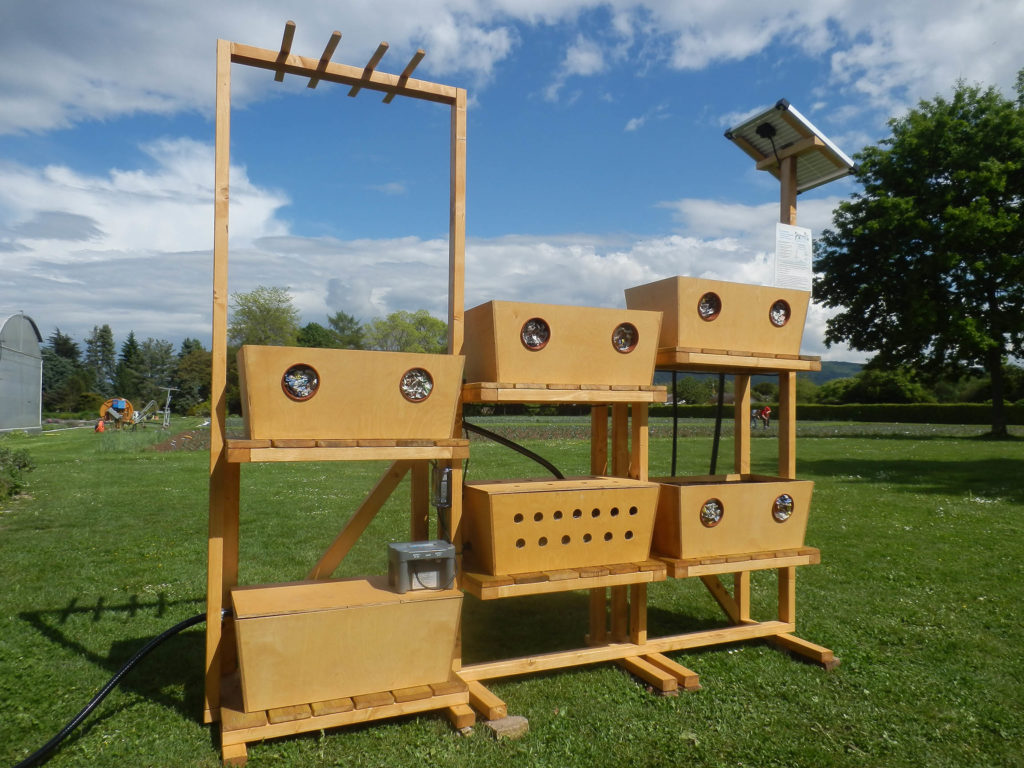
Q: What is special about your system compared to others?
Bastian: As a result of producing your own food right in the city, Geco-Garden systems create a direct connection between humans and nature. We combine the following topics in a unique way: direct waste recycling, natural matter cycles, renewable energy, modern technologies and ecological cultivation methods:
- You use our own organic kitchen waste for growing agricultural and ornamental plants
- Gardening made simple: No need for manual watering, thanks to the automated watering and nutrition circuit, which also fertilizes the plants
- You decide, what and how you grow: The decentralized food production reduces the transport of food in cities, thus saves energy and greenhouse gas emissions
- Collaborative gardening promotes social interaction and allows you to share your harvest with others, which creates rich crop diversity.
Consumers become producers
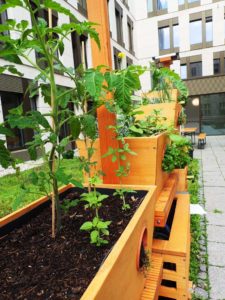
Q: Who are your typical customers and what are their most common crops grown with the system?
Bastian: Most customers of Geco-Gardens are private people e.g. young families living in urban areas. They want to have their own little garden for a healthier lifestyle and a closer connection to nature or show their kids how organic food is produced. We even have pensioners as customers. They appreciate the automated and thus convenient way of gardening without having to bend down.
Besides private people, our garden systems are very interesting for companies and other organizations that want to show their green engagement. A third customer segment are kindergartens and schools, to teach kids natural food production cycles from an early age.
You can grow any kind of vegetables, herbs and fruits in your garden system- The selection depends on your choice and the location of the garden system – the more sunlight, the larger the selection of crops. Typically our customers grow different herbs like basil, oregano, thyme, rosemary and mint, a variety of lettuces and other leafy greens as well as vegetables like tomatoes, cucumbers, peppers and chilies. At warm locations even melons will fruit!
Q: How much effort do your customers have to put in for growing their crops?
Bastian: The effort is very low: Sowing or planting with little watering in the beginning; feeding the compost worms and fill up the water tank once a week; harvest and consume. Furthermore, the pressure from pests and deseases is much lower in the city. Usually, there are no snails on a balcony 😉
Q: What is your long-term vision?
Bastian: The vision of Geco-Gardens is to create new gardening areas in cities for organic self-production of food. The reasonable use of modern technology in combination with ecological cultivation methods and the use of your own hands can transform urban resources directly into tasty food – diverse, local and organic. With Geco-Gardens, consumers become producers. Food production becomes decentralized, seasonal, regional, divers and therefore more sustainable.
Q: And what are your next steps?
Bastian: We want to bring our systems and our company to the next level. Therefore we cooperate with the software startup farmee (yay!) and entrepreneurship expert Dr. Christoph Mandl of ‘Zugspitze Ventures’ – together we form a team for the KATANA accelerator programme, which is funded by the European Union.
We will add a sensor based app to our existing system, so you can monitor your plants with your smartphone. This will automize the system even more, because you can control the water and nutrient cycle from anywhere, e.g. from the office or when you are on holidays. In addition, the app will provide an interactive guidance from sowing to harvesting. Growing healthy food on your own balcony will become as simple as playing Farmville on Facebook – but with real crops!
Watch out for our crowdfunding campaign coming in fall 2017! It would be awesome to get some support from the community so we can improve our product and enable more people around the world to grow their own organic food.
All pictures (c) by Geco-Gardens
So, what is farmee and why the heck should I care?
You should care about farmee because it will revolutionize the way we grow our own food in cities.
Ouch, yes, we used the word revolution in the first sentence of our first blogpost. Is that a good idea? Probably not… But now it’s out there and we can’t take it back, so why not stick to it? We’re on a mission to make smart farming simple. We set out to lower the threshold to the world of sensor- and software-driven farming, making it accessible for you and your mother. If that’s not a revolution, then what is?
Who are we?
We’re a group of five friends sharing a passion for technology, entrepreneurship and great food! We’ve spent the last couple of years founding and running different companies, but ultimately decided to commit ourselves to something really important: food production. We believe, food production should not only be run to huge corporations, so we’re empowering people to grow their own food. But hey: there’s nothing bad in commercial farming per se, plus there are amazing people out there dedicating their lives to developing sustainable yet forward-looking farming methods. We’re absolutely sure there will be commercial farms running farmee software in the near future and we’ll totally dig it!
So, we’re on a mission to make smart farming easy.
Why now?
To date, cities produce nothing but waste. At the same time, more and more people live in cites and overall population is rising to 9.7 billion people by 2050. There is serious doubt there is enough farmland to feed that rapidly increasing number of people. If farmland is unable to expand, we can only rely on technology to increase crop yields and developing areas that used to be unsuitable for food production. Smart farming can achieve just that, as there is no need for soil, natural light and the necessary amount of resources can be reduced to an absolute minimum.
(By the way, if you’re interested in these things and want to know more, here are some good places to start: https://esa.un.org/unpd/wup/publications/files/wup2014-highlights.Pdf here: https://esa.un.org/unpd/wpp/publications/files/key_findings_wpp_2015.pdf and here: How to feed 11 billion people: Addressing the 21st….)
Building our own rack
We’ve been busy building our own prototype grow racks lately and they’re pretty awesome! It’s also a huge pain in the ass to do so from scratch, there’s a shitload of cables, tiny sensors with connector plugs going nowhere, more cables, tubes, water tanks, pumps, led-strips, raspberry pis, more sensors and so on. And then there’s lots of soldering involved, cutting, glueing and even planning in advance. Of course, we’re exaggerating a wee bit and in reality, it’s totally fun and a huge adventure. But, at the same time, we wished there was an existing resource with helpful tutorials and the like, because to be honest: it’s really hard to build a working rack. You have to learn a lot if you’re planning to build your own vertical farming rack and possible points of failure are countless.
So, to cut to the chase, we are going to be that resource. In this blog you will find a ton of helpful content, like our own construction plans, how-tos and featured interviews with experts in different fields (even actual farmers!). We’ll also post thought experiments like plant recipes (more on that later), tailor-made hardware-packages, software-architecture and, on a more general note, the future of farming.
Plant recipes
If we’re serious about making smart farming simple, we first need to make farming simple. A lot of folks, ourselves included, know very little about growing plants these days. How much water does a specific variety really need? Which nutrients are important to drive growth? What the fuck is molybdenum? We believe to have an easy solution for that and we call them plant recipes. We’ll get back to these as soon as possible in a dedicated blog post, so if you’re having a hard time figuring out what your plants need: we have you covered!
farmee as a software platform
Plant recipes and prototype racks aside: our core product is going to be a software platform, part operating system, part eco-system. It has quite some tricks up it’s sleeve: You’ll be able to plan your own farm, choose crops of your taste and combine them into useful zones. You can hook it up to a ton of different sensors and actors to measure conditions like temperature, humidity, PH, EC, ambient light and infrared, as well as trigger actions such as water pumps and lights, for example. It will seamlessly integrate our plant recipes to feed your plants exactly the way they need, without you having to be a farmer yourself. Development for farmee is already in full swing, so it’s hard to summarize all our thoughts in a single paragraph, so stay tuned for more!
That’s it for the moment, make sure to come back next week for more. And from there on: every week!
farmee – smart farming made simple

